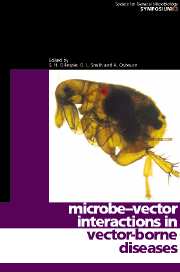Book contents
- Frontmatter
- Contents
- Contributors
- Editors' Preface
- 1 Vector-borne diseases
- 2 Evolution of tick-borne disease systems
- 3 Insect transmission of viruses
- 4 RNA-based immunity in insects
- 5 Specificity of Borrelia–tick vector relationships
- 6 Bunyavirus/mosquito interactions
- 7 How do mosquito vectors live with their viruses?
- 9 Vector competence
- 9 Environmental influences on arbovirus infections and vectors
- 10 Vector immunity
- 11 Transmission of plant viruses by nematodes
- 12 Wolbachia host–symbiont interactions
- 13 Pathogenic strategies of Anaplasma phagocytophilum, a unique bacterium that colonizes neutrophils
- 14 Interactions of Yersinia pestis with its flea vector that lead to the transmission of plague
- 15 Transgenic malaria
- 16 Vaccines targeting vectors
- Index
9 - Vector competence
Published online by Cambridge University Press: 06 July 2010
- Frontmatter
- Contents
- Contributors
- Editors' Preface
- 1 Vector-borne diseases
- 2 Evolution of tick-borne disease systems
- 3 Insect transmission of viruses
- 4 RNA-based immunity in insects
- 5 Specificity of Borrelia–tick vector relationships
- 6 Bunyavirus/mosquito interactions
- 7 How do mosquito vectors live with their viruses?
- 9 Vector competence
- 9 Environmental influences on arbovirus infections and vectors
- 10 Vector immunity
- 11 Transmission of plant viruses by nematodes
- 12 Wolbachia host–symbiont interactions
- 13 Pathogenic strategies of Anaplasma phagocytophilum, a unique bacterium that colonizes neutrophils
- 14 Interactions of Yersinia pestis with its flea vector that lead to the transmission of plague
- 15 Transgenic malaria
- 16 Vaccines targeting vectors
- Index
Summary
INTRODUCTION TO THE CONCEPT OF VECTOR COMPETENCE
The importance of vector-borne diseases
Infectious diseases remain the leading causes of morbidity and mortality worldwide and arthropod-borne diseases include many of the most important, especially in the tropics and developing countries. For example, malarial parasites infect an estimated 200 million people annually in Africa alone with mortality estimates of about 1 million persons, primarily children (Greenwood, 1999). Vector-borne viruses are also important human pathogens. Approximately 2500 million people (two-fifths of the world's population) are at risk from dengue with about 50 million cases each year (www.who.int/inf-fs/ en/fact117.html). Many other vector-borne pathogens cause emerging diseases that have undergone resurgence or threaten to increase in prevalence or distribution in the coming years. However, despite the importance of vector-borne diseases, the mechanisms of transmission of many vector-borne pathogens remain poorly understood.
Here, we review the various factors that contribute to the transmission of pathogens by arthropod vectors. Due to space limitations, we focus primarily on human disease, with emphasis on mosquito-borne pathogens, especially arthropod-borne viruses (arboviruses).
Mechanisms of pathogen transmission by arthropod vectors
Vector-borne pathogens of humans and other animals circulate between their arthropod vectors and vertebrate hosts. Arboviruses represent the most basic form of vector-borne transmission, and undergo horizontal transmission between vertebrate and arthropod hosts (Fig. 1). In some cases they are maintained by vertical transmission from adult arthropod to offspring. Usually a restricted invertebrate host range is observed with only one or few vectors involved in transmission. Within the infected arthropod, the virus must undergo an extrinsic incubation period of variable duration before biological transmission to a susceptible vertebrate host (Fig. 2).
- Type
- Chapter
- Information
- Microbe-vector Interactions in Vector-borne Diseases , pp. 139 - 180Publisher: Cambridge University PressPrint publication year: 2004
- 3
- Cited by



